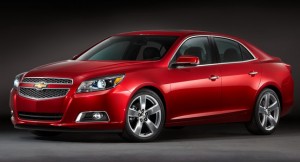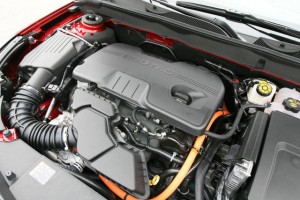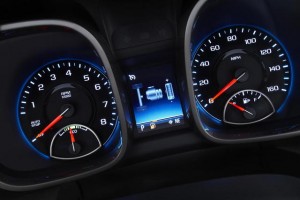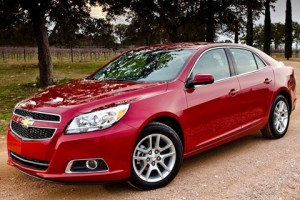The 2013 Chevy Malibu is the first “normal” car to come standard as a hybrid car. Two non-hybrid versions will be arriving later this summer, but for the moment, if you want a Malibu, you’re looking at a hybrid Malibu Eco.
It’s an interesting strategy. But is it sound policy?
One of the Malibu’s target competitors – the Hyundai Sonata – gets almost the same gas mileage (24 city, 35 highway vs. 25 city, 37 highway) without the hybrid technology – or the hybrid price tag. The $25,235 Malibu hybrid starts out about $5,000 more than its $19,795 to start Hyundai adversary – a tall stack of bills.
And the comparably priced Toyota Camry hybrid ($25,900) gets 43 city, 39 highway – a tall stack of MPGs.
Like the Chevy Volt electric car, the Malibu Eco hybrid is a neat piece of engineering – and a nice car, too. But ultimately, its success or failure will depend on whether enough buyers think it’s worth the coin.
WHAT IT IS
The Malibu is a mid-sized, FWD sedan that – for now – is sold only in hybrid Eco form. The Malibu Eco is a so-called “mild” hybrid, meaning the gas engine turns itself off when the car is stationary – and an electric motor/battery pack provides an assist when it is accelerating . But unlike full hybrids such as the Toyota Prius (or the new Camry hybrid) the Malibu Eco doesn’t have the ability to move down the road solely powered by electricity – and you can’t plug it in to recharge its batteries.
Base price is $25,235.
As summer rolls on, Chevy will add a lower cost base trim (non-hybrid) to the lineup as well as a sporty turbocharged version.
Competition includes the Hyundai Sonata, its cousin the Kia Optima, the Toyota Camry and the Ford Fusion.
WHAT’S NEW for 2013
Everything. The ’13 Malibu is all-new
WHAT’S GOOD
Mild hybrid layout is unobtrusive and fuel efficient: Compact car MPGs in a mid-sized package.
Nicely finished, inside and out.
Comfortable, wide-bottomed seats.
WHAT’S NOT SO GOOD
Gas mileage only slightly better than non-hybrid (and less expensive) versions of the Hyundai Sonata/Kia Optima, Ford Fusion and Toyota Camry.
Comparably priced Camry hybrid offers much better city mileage (43 MPG).
Non-ergonomic manual shift control for six-speed automatic transmission.
UNDER THE HOOD
At the time of this review in late April, the Malibu was being sold only in mild hybrid form – “Eco” in Chevy-speak. A 2.4 liter engine with direct injection and variable valve timing is paired with a small electric motor and 15 kW lithium-ion battery pack for extra boost during acceleration and also to provide power for accessories when the car is stationary.
Total combined power output is 182 hp.
A six-speed automatic transmission with manual shift control function is the standard (and only) transmission in the Malibu Eco.
The combo is good for an 8.7 second 0-60 run and 25 MPG city, 37 MPG on the highway.
These are pretty solid numbers – except for one thing: Competitors’ numbers are even better.
The non-hybrid (and only $19,795 to start) Hyundai Sonata has 198 hp and still manages a very respectable 24 MPG city, 35 MPG highway – a virtual dead heat with the Malibu Eco. The Sonata’s sportier – and slightly less expensive (but functionally identical) Kia cousin, the $19,500 Optima likewise delivers the same nearly-hybrid fuel economy without the hybrid Malibu’s much higher sticker price.
There is also the hybrid version of the Sonata to consider. Its MSRP of $25,850 is about the same as the Malibu Eco’s price – but the Hyundai hybrid delivers significantly higher MPGs: 34 in city driving, 40 on the highway. Note that the Hyundai hybrid’s city mileage is almost 10 MPG better than the Malibu Eco’s.
The hybrid Toyota Camry ($25,900) does even better: 43 city, 39 highway. That’s nearly 20 MPG better in the city – a tremendous difference – for about the same price. And as with the Hyundai, the non-hybrid version of the Camry nearly matches the MPG performance of the more costly Malibu Eco: 25 city, 35 highway for $21,955 vs. $25,235 for the Chevy.
There’s also the Ford Fusion to consider. The hybrid version does cost about $2k more ($28,775) but its fuel economy is excellent: 41 city, 36 highway. And the regular (non-hybrid) Fusion does almost as well as the Malibu hybrid: 22 city, 32 highway – and does it for only $20,705.
A third option you might want to look at is the $25,995 VW Passat diesel. It gets 31 city, 43 and costs only a few hundred bucks more than the Malibu Eco hybrid. I’d personally choose a diesel over a hybrid for the long-haul. Ten or fifteen years down the road, the diesel will probably still be delivering the goods. But over that span of time, a hybrid’s batteries will probably deteriorate in performance (ability to hold a charge), reducing the efficiency of the drivetrain and possibly requiring expensive replacement.
ON THE ROAD
The Malibu Eco’s hybrid drivetrain is almost unnoticeable unless you happen to notice that the engine has turned itself off while you’re waiting at a red light – by visually glancing at the tachometer, not by ear. Or if you happen to be watching the power-delivery display on the LCD flat-screen monitor – which shows you what’s going on as it’s going on. The auto-start function is seamless . In some hybrids I’ve driven, you can hear and feel the gas engine re-start. The Malibu is more finessed and refined in this respect. 
It also helps that the Malibu has a conventional six-speed automatic rather than a continuously variable (CVT) “one speed” automatic. There’s less engine/drivetrain noise when accelerating – although not using a CVT probably cost Chevy a couple of MPGs that the Malibu Eco really could use. The fuel economy benefit is why you’re noticing more CVTs in service – including in hybrids such as the Ford Fusion hybrid. (The Hyundai Sonata, on the other hand, uses a conventional automatic and still gets extremely good mileage; with a CVT, it’d probably do even better.)
Acceleration is neither weak nor strong – it’s very middle of the road. For what it is – and what most buyers probably expect – it is certainly sufficient. Like almost any new car, once you’re in top gear, you can trundle along for hours at 75-plus effortlessly, with the engine barely running 2,000 RPM. Getting to 90, 100 mph – and more – is deceptively easy. There’s no sign of strain until you’re well beyond ordinary speeding ticket territory.
The tragedy of our time is how effortlessly fast (and fairly fuel efficient when running fast) even “family” type cars like the Malibu are – and how illegal it is to make use of what they can do. Given the realities of the American road, a bit less can’t-really-do-much-with-it capability in exchange for better everyday mileage would probably be a good swap. 45 MPG and 100 MPH, all out vs. 37 MPH and probably 120-plus.
Handling is a high point – not because the Malibu Eco corners like a BMW but because the Malibu Eco doesn’t corner like most hybrids. It feels… normal. Not ass-heavy (or just heavy) as many hybrids do because, well, they are. Having several hundred pounds of batteries bolted to the floorpan is not unlike having several hundred pounds of bricks in the trunk. The typical hybrid car sways and lurches in the curves and when you brake, you feel all that weight trying to keep right on going. But Chevy has very effectively damped the Malibu’s suspension so that the extra weight doesn’t show itself like a beer belly in a T-shirt two sizes too small. The Eco even feels eager at a clip just above the legal – and it’s only when you’re well into the not-legal that it begins to get ruffled. But not unsettled. Just the normal body lean and lower grip threshold you’d expect to encounter in a family-type car being pushed harder than it was meant to be pushed. That’s all. The Malibu Eco hybrid feels more steady and confident than a non-hybrid Camry – the best ’87 Buick Regal Japan ever made – and a helluva lot more so than a hybrid Camry. It also handles with greater agility/confidence than the Sonata hybrid.
Driving-wise, it’s one of the best (if not the best) car in its class.
If it only it got better gas mileage.
Or cost less.
Chevy has been clumsy in the past as far as incorporating styling elements of its popular models into bread-and-butter models. A recent example of this being the cartoonishly over-large retro-round taillights grafted onto the tail end of the current FWD (and V-6) Impala to try to conjure up fond memories of the old RWD (and V-8) muscle car Impalas of the ’60s. It didn’t work because there was nothing in common between the two cars except the name. Square peg, round hole – or the reverse.
This is different. Chevy stylists took cues from the current Camaro and blended them into the Malibu; you’ll see the DNA manifesting in the shape of gauge cluster and tail-lights, the semi-fastback rear glass, the overall hunky squat of the car. It’s integrated – not a grafted-on afterthought.
No fault to find with the car’s lines – or its insides. The cabin of the Eco I tested was everything the PR sheet said it would be – “premium,” in car-biz lingo. Individually fitted panels (including the “toupee” over the gauge pod) covered in convincingly soft-touch leatherette material, with equally believable stitching buttoning it all up.. The chrome bits have a rich, deep, almost liquid look; the wood inserts aren’t obvious plastic. That plus features and equipment the previous Malibu lacked – such as GPS and music streaming via the Internet – amount to a Great Leap Forward over the previous Malibu, which was a competent enough car but far from “premium.”
It’s also really quiet – Chevy says the quietest car it has ever made. I believe this, too.
One deficit relative to some of the competition is interior space. The Malibu’s got 39 inches of front seat headroom and 42.1 inches of front seat legroom. This is not cramped – it’s actually about the same as you’d get in the Ford Fusion (38.7 inches and 42.3 inches, respectively) and a bit more than you’d get in a Camry (38.8 inches and 41.6 inches).
But it’s noticeably less spacious than the Hyundai Sonata’s almost full-sized car accommodations: 40 inches of headroom and 45.5 inches of front seat legroom – that’s 3.4 inches more than in the Chevy.
The Malibu does make up for this in the second row, which has 36.9 inches of legroom vs. the Hyundai’s 34.6 inches (headroom in the second row is a dead heat between the two; 37.6 for the Malibu and 37.8 for the Hyundai).
Trunk space is 14.3 cubic feet – decent – but slightly less than the Sonata’s 16.4 cubic foot trunk, the Camry’s 15.4 cubic foot trunk and the Fusion’s 16.5 cubic foot trunk.
There’s nothing objectionable about this car – other than the slightly awkward-to-use controller for changing gears manually, which is mounted on top of the shifter. To go up or down you have to move your thumb forward and back, pushing down to engage the + or the -. It’s not very ergonomic. I’m also not a huge fan of the electrically-actuated parking brake my test car came equipped with. Sure, it’s a neat gadget and it does free up space on the console that might otherwise be taken up by a manual pull-up parking brake. But, two things: That electric actuator will probably cost a small fortune to fix when it fails. And eventually, it will fail. I’d rather have a simple, functional, manual-control cable. Also, note my use of the term, parking brake. What you don’t have is an emergency brake. If a car has a pull-lever brake on the console, and there’s a failure of the main braking system, you can use the emergency brake to slow the car down in a controlled manner. This is not possible with the electric parking brake, which cannot be modulated. It’s either on – or off. Even if the system let you engage the parking brake while the car is moving (which it probably won’t) the result be immediate wheel-lock and an uncontrolled skid. Not good.
So, give me the manual pull-up emergency brake every time.
But, small potatoes. Overall, this is a really nice car. Premium look, feel and function.
THE BOTTOM LINE
I like this car – it’s a good car – I’m just not sure whether I can recommend this car given what you can get, MPG-wise and otherwise, at a Hyundai, Kia or Toyota dealer for the same or less money. Chevy needs to figure out a way to get either the city or the highway MPGs into the 40s in order for the Eco to be competitive with what’s on the market right now. And also what’s on deck. Ford has an updated 2013 Fusion coming in a few months – and it’s sure to deliver even better mileage than the 2012 version. Which is going to make things that much rougher on the Chevy.
It will also be interesting to find out is whether the soon-to-be-here non-hybrid Malibu will be comparably quick – and comparably fuel-efficient – for less money than the $25,235 Malibu Eco.
Chevy might end up undercutting itself, too.
Throw it in the Woods?












http://i.ebayimg.com/t/FORD-BENDING-CHEVY-FUNNY-DECAL-STICKER-TRUCK-EMBLEM-/00/s/NDA3WDM3NA==/$(KGrHqZ,!kwE8N2+jqE4BPD4SO2)yQ~~60_35.JPG
Cars like this wouldn’t exist but for government edict. Why DO we allow people with no fucking idea what they’re talking about to make the rules?
Using adapted F1 chassis technology, a family vehicle could be manufactured that would weigh less than a ton and yet have all the crash protection one could want.
With such a low weight, a high-efficiency diesel or small four-cylinder with, say, 120 hp could throw it around like a prison bitch in a cell block riot, and get 70 MPG doing it.
I swear, this hybrid-car business is a technological misadventure so grand and poorly-thought-out, you could be forgiven for thinking it was dreamed up in some kolkhoz outside Severodvinsk in 1960.
Why DO we pay their salaries? The government has forgotten, like Governor Huckabee says, we are the bosses. The citizen is the boss. They work for us.
Hey, there’s a thought!
No elected official should ever receive a paycheck for his service.
That might prevent a lot of the sort of nonsense we have to deal with.
The paycheck is the least of their compensation for political office. Otherwise why would someone spend millions for a job that pays thousands?
Exactly what I was thinking!
Exactly, that’s why whenever a “businessperson” spends millions of their own money to win a political office, you know that they expect a proportionate ROI.
People are still so naive as to think that they are doing it because they want to “help” people. They’re doing it for our own good. The idiocy in this country is staggering.
Very true BrentP. I read once that most people reach the point of maximum happiness at around $50K per year (probably more like $75K by now with inflation). But the point is that once you have all of your food, clothing, shelter and transportation needs more than adequately met, with money left over for entertainment and savings, more money won’t make you any happier. Once you have enough money to go anywhere you want to, do whatever you decide and no longer have to work for a living, what’s left? Power and adulation, of course. That’s what these fascist rent-seeking political whores are after; recognition, fame and power. They get off on having people bow down and kiss their asses for table scraps like dogs on the palace floor. The also get a sick thrill out of wielding the power of life and death over any that would dare oppose them (hence the “war on terror”, the NDAA, etc.). And their sadistic bent shows up in their use of torture and incarceration of any they deem “guilty” without due process of law (or even the pretense of it anymore).
As we’ve discussed here numerous times before, the sociopathic narcissists have taken over; they see the rest of us as barn yard animals here solely for their own use. Don may be right in that we spend too much time bitching and not enough taking proactive measures against the regime. But much of what we discuss is actionable. Whether you pay a workmen in cash and tell him “I don’t need a receipt” and even (gasp!) tell him you’d appreciate it if he didn’t report it, run that ridiculous stop sign (while watching for Officer Friendly) or shooting a speed control camera in Santa Fe http://www.bing.com/videos/search?q=man+shoots+speed+camera+video&mid=04B4A0569F1244D3202304B4A0569F1244D32023&view=detail&FORM=VIRE4&adlt=strict (be sure to cover you license plate and wear your Guy Fawkes mask if you decide to emulate this fellow though), every little nip at Leviathon’s ass redirects ever thinning resources to swatting flies. This makes the inevitable collapse more imminent. It’s the little things in life that warm the heart. 😀
Material happiness may come at that point, but not freedom. Freedom in this regard is having nothing or having so much that one is free of being messed with.
I agree that those who want power are defective, twisted, and/or sick individuals. I believe that the popular vote is no way to do anything. I’ve been trying to figure out a new way to do a representative republic. Now bare with me, I’ve but about 10minutes into this total. I am thinking it should be like jury duty. Someone is just randomly selected to hold office for a term. They get a notice in the mail and they find out they are now have to serve in congress or as president or whatever.
The big problem is that is using force. So it needs refinement. Should always be someone who has skin in the game too. Also the short time in office to do things might cause problems but it should be less than we have now.
At least it would change people’s attitudes about government. Break some of the illusions.
Stupid news program, it’s not a police van, it belongs to a private corporation.
As far as taking action, direct confrontation isn’t going to work. So all we can do is be informative. Be a constant injection of information and logic that spoils illusions and breaks the spell for one person after another.
When they get hit personally they’ll remember they were warned.
The system requires so many people to play along that this is its greatest weakness. No matter how strong the government gets, this weakness can make it fall apart in hours.
Like Minority Report…Anyone who even thinks about becoming a politician needs to be eliminated from civil society.
Because “consent” is a fiction. We’re not their bosses. Far from it. A boss exercises control; he has authority. How much control do you or I or any of us (who’s not one of the corporate-political elites) have over anything? What authority do we have to govern even our own lives? Not much. The ingenious thing called “democracy” has provided the serfs – that’s us – with the pitiful fiction that we’re the “bosses.” Much to the delight of the real bosses.
So true. I remember a time when the culture really was one of “they work for us”. But now, nobody ever really says or thinks that. Everybody knows, that they are our “rulers”. They live like kings and queens off our money and if you complain, you will be punished.
Nobody feels that the cops are there to “protect and serve”. We have quitely settled down into our subservience bitching and complaining when it’s politically correct to do so and keeping quite when it’s not.
Puke!
Amen. I’ve been screeching about this for years. Cars keep getting heavier and heavier (and more and more expensive) in order to placate the government and meet its endless “safety” standards… with the result being embarrassingly poor fuel efficiency and Rube Goldberg “solutions” such as hybrid drivetrains.
A 1,500 lb. car with a modern direct-injected three cylinder engine and six-speed transmission would surely be able to deliver 50-60 MPG and adequate performance without the need for any elaborate technology or over-the-top expense.
It might not be as crashworthy as a 3,800 lb. Safety Car – but personally, I’d rather have the 60 MPG. I’m an excellent driver; I haven’t wrecked a car since 1987. I’m willing to take the “risk.” The everyday advantage of 60 MPG is far more desirable to me than the theoretical advantage of crashworthiness that’s only relevant if I wreck, which I probably won’t.
I’d like to be able to make the choice for myself – but I’m not allowed to.
One very good way you can tell something’s a scam is if it can’t be permanently fixed, only endlessly treated.
Like how cars can never be safe enough, or psychological “conditions” like autism can’t be cured, or public schools can never have enough money.
Safety is a scam, at least in the modern, popular way America defines it.
I’m no masochist, I just have a sense of proportion.
Absolutely.
It’s always about the money (and control).
Someone else posted that if motorcycles were not already in existence, if they had just been proposed, they’d never be allowed. Not “safe” enough.
I strike at the root of all this stuff. My “safety” is no one’s business but mine. If other people decide that riding a motorcycle is too “risky” for their comfort – or prefer to spend their money on air bags (and a car that weighs 3,800 lbs.) that is certainly their right.
But they have no right to tell me I can’t ride – or what to ride (or what to wear while riding) or force me to buy air bags or a 3,800 lb. car.
This is the message we’ve got to get across to people: MYOB!
This is a much heavier car than Sonata.
The mild hybrid seems like a waste of time although it is a much simpler design. There really is no alternative to hydrocarbons except possibly hydrogen fuel cell but nuclear power needs to come online before cracking hydrogen becomes viable.
Thermodynamics/physical reality is a bitch! But thanks to publik skewl, TeeVee, and high carbohydrate/low fat diet – Little Clovers can not even BEGIN to understand reality or even have the ABILITY to be free.
Well-said, DD!
Here is a car that will bring no new buyers to GM. Only hard core Chevy folk will consider it. And even among them, you gotta wonder how many really want a hybrid that handles well, but does not deliver excellent mpg.
Perhaps the standard engine models will draw fleet buys from Hertz and Budget. Bet they will be available cheap.
Too bad. The Malibu marque once had a bit of panache. Not now.